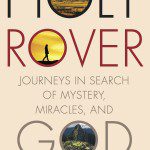 For the past few weeks I’ve been slowly reading my way through T.M. Luhrmann’s When God Talks Back: Understanding the American Evangelical Relationship with God
For the past few weeks I’ve been slowly reading my way through T.M. Luhrmann’s When God Talks Back: Understanding the American Evangelical Relationship with God. Critics have compared it to William James’s The Varieties of Religious Experience, the classic work on the psychology of religion published in 1902. I agree that this is an important, groundbreaking book. It’s also the clearest description I’ve ever read of what faith looks like from the inside. I found it intriguing, challenging and at times mystifying, in the best sense of the word.
Luhrmann is an anthropologist at Stanford University who spent four years among evangelical Christians at churches in Chicago and California. During her time in these communities, she made no secret of the fact that she was an anthropologist intending to write a book. She was nevertheless welcomed warmly. She participated fully in the lives of these congregations, attending Sunday services, prayer meetings, and small groups. She interviewed parishioners one-on-one, listened to their stories, and became friends with them. Her goal was to answer two questions: how can rational, sensible people sustain a belief in God while living in a culture that is increasingly scientific and secular? And how do these Christians maintain an intensely alive, personal relationship with God, to the point that they feel that God actually speaks to them?
Luhrmann describes herself as an agnostic, but she is sympathetic to religion and open-minded about religious claims. Writing about her project in the Huffington Post, she says this:
Evolutionary psychologists have argued that the fundamentals of religion are undergirded by our cognitive structures, so that the idea of an invisible agent automatically seems plausible. But it is one thing to feel intuitively that there might be a God, and another to sit down across from an empty table for a conversation and believe that you are not talking to the empty air. What I saw as an anthropologist was that experiencing God vividly required work. It required skill and it required practice. People had to practice imagining that God was present again and again. This does not mean that God is imaginary: the senses capture only the material world, not an immaterial one. It does mean that those who sought to use their imagination had to learn to take what they imagined seriously, and not treat it as ephemeral thought.

What I found so striking as an anthropologist is that prayer changed people, not so much morally or emotionally, although prayer might change people in these ways, but in their capacity to imagine. Prayer changed the way people used their imagination and it changed the quality of their imagination, so that what they imagined felt more real to them. They became able to feel God beside then as they walked. They experienced God as talking back. They needed to use a new “theory of mind” to do this — they needed to be taught that what happened in their imaginations could be real. But when they practiced taking what they imagined seriously, they began to feel that they had evidence that God was real and responding to them.
It is important to recognize the trained imagination at work in evangelical prayer because otherwise this style of faith can seem incomprehensible, even foolish, to onlookers. It is neither. These evangelicals are using a style of faith practice used by the desert fathers and medieval monks and — in different forms — by different faith communities around the world. They use these practices because these practices make God more real.
There were many things I found fascinating in this book, particularly the stories of how people experienced God in their lives and how their prayer lives changed over time. Luhrmann’s discussion of the role doubt plays in Christian life is worth the price of the book alone. I also found it interesting how Luhrmann connects this evangelical form of prayer with much older traditions–in particular, with St. Ignatius of Loyola’s Spiritual Exercises, a highly influential work in Roman Catholic spirituality written in the sixteenth century. Reading this book made me vow to do these Spiritual Exercises myself (but that’s another blog post).
I’ve read a great deal over the years about prayer, but this book was a revelation to me. Mainline Christians–not to mention the secular world–too often dismiss evangelical prayer as simple-minded. This book shows that it can be complex and intellectually sophisticated, part of a spiritual tradition that extends far beyond Christianity. Sometimes it takes an outsider’s view to make us appreciate what we have overlooked.














